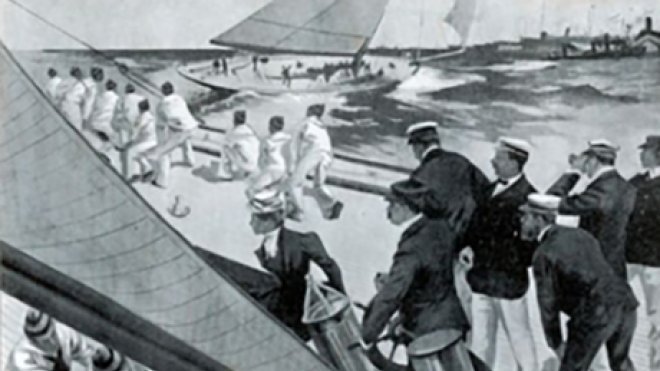From the Depths of History, Early Women Sailors Surface in Student Research Project
History majors partner with Herreshoff Marine Museum on new exhibit

BRISTOL, R.I. – There’s an ancient superstition among seafaring folk that to bring a woman aboard a boat was bad luck – that she would distract the sailors from their work, turning the sea against the ship.
Still, if you dredge the depths of history – as a handful of RWU students did during a recent partnership with the Herreshoff Marine Museum – the contributions of women sailors to the sport of sailing start to surface.
“It used to be incredibly unlucky to have a woman on a boat of any kind, so just having these women on these boats was incredibly significant,” says Assistant Professor of History Charlotte Carrington-Farmer, who oversaw the project facilitated by the Community Partnerships Center at RWU. “We see through into the 20th century that women start to play a bigger role in yachting.”
At the behest of the Herreshoff Museum – a treasure trove of maritime artifacts, yachts, and replicas as well as home of the America’s Cup Hall of Fame – a team of six students spent a semester researching the contributions and impact of America’s Cup sailors Hope Goddard Iselin, Gertrude Vanderbilt, Phyllis Sopwith and Susan Henn for a new exhibition. The team had little to start with – just the names of the womens’ husbands and the yachts they raced on. But granted full autonomy to determine the direction of their research, history majors Sean Carroll, Alexandra Guzman, Timothy Kelleher, Breanne Messier, Austin Richard, and Rebecca White focused on archives in sailing communities from Newport, R.I., to Connecticut – even Vanderbilt University in Tennessee – to piece together histories of these largely unknown women.
“The most surprising thing we found was that these women were a lot more involved than anyone had ever thought they were,” says senior Austin Richard. “Everyone assumed they were just supposed to look pretty on the boats with their husbands, but they were powerful women and sailors in their own rights.”
The group was particularly intrigued with Hope Goddard Iselin, the first woman ever to compete as a crew member in the America's Cup. As the oldest subject, the group expected to find the least amount of background on her, but actually found the most. Iselin golfed with the Russian Grand Duke, was seen in the presence of Queen Elizabeth II, was the chairwoman of three gardening clubs across the northeast, and built a hospital and a school for girls in South Carolina – all in addition to her yachting achievements.
The students curated four research booklets that they presented to the Herreshoff Museum on Jan. 21, and pitched ideas for how the museum could display their findings. In addition, the students were so inspired by Iselin’s legend that they expressed support for her nomination to the America’s Cup Hall of Fame.
Says Richard, “It’s important to me that we were able to let these four women come to the forefront of history, and to let other people hear their names and their stories and know that they were women of importance.”